TREKELL CUSTOMERS ASK: WHY DON’T MY BRUSHES LAST A LIFETIME?
Many artists want to know why their brushes don’t always last a lifetime. Paint brushes can certainly last for a long time, but their durability and longevity depends in part on how they are cared for. If brushes are treated with care and properly cleaned and conditioned, you’ll get far more bang for your buck and your favorite brushes will stand the test of time. Expectations need to be fluid and adjusted according to how much time and effort you are willing to put into caring for your brushes. If you don’t take the time to do your part, you can’t expect your brushes to take repeated beatings and keep performing at a high level. Conversely, if you do take the time and effort to clean and condition them properly, you’ll have brushes that perform well for a very long time.

First, you need to determine how to care for your brushes based on whether they’re composed of synthetic or natural hair. Different types of brushes require different products and levels of care. There are several issues related to caring for synthetic brushes we often receive feedback about:
Synthetic brushes tend to "curl" and this can happen because of the mediums artists are using. Once synthetics are altered by something chemically and it "melts" them, they're almost impossible to save. Just like synthetic hair extensions or wigs, you should not treat synthetic brushes with heat, dyes, or chemicals.

Natural hair brushes must also be cared for according to what will appropriately clean and condition them. A good way to remember how important that is would be to consider your own hair--imagine using paint and paint mediums on the hair on your head. How would your own hair end up looking if you didn’t wash and condition it? It would probably be gummed up, stuck together, and in terrible shape. Envision that next time you find yourself getting lazy with your brush cleaning routine.
Another factor in how quickly a brush wears out is how small or fine the tip is. The smaller or more fine the tip of a brush, the faster it will wear out. That's why proper brush care is important. However, brush care will only help maintain the life of your brushes; it isn't going to make them last forever. Again, realistic expectations are key.

Nothing is made to last forever and ever. But of course there are steps you can take to prolong the existence of your brushes.
Proper Brush Care Do’s and Don’ts
- Do keep the ferrule clean--don’t get paint all the way up to and on the ferrule itself

- Do take off excess paint with a shop towel or soft rag--never leave paint in your brushes

- Don’t leave brushes soaking for a long period of time--it’s tempting to let them soak overnight but prolonged periods submersed in liquid isn’t good for them

- Don’t let the brush rest on its head--get brush suspenders so the brushes mostly retain their shape before you complete the reshaping process by hand

- Do clean the brush according to what type of bristles it has and what type of paint was used--different products for different paint types i.e. oils need linseed oil soap, acrylics do great with coconut oil soap, as do other water-based mediums .


- Do reshape the brush with your fingers and leave standing upright on its handle to dry--proper brush storage is really important

- Do use brush restorer--this step really does make your brushes seem like new


- Don’t use heat; use conditioner or brush restorer to maintain the brush point
While most brushes won’t last forever, preventative maintenance in the form of proper brush care is key to stretching their life expectancy. By putting in a little extra time and effort to keep your art materials in their best shape, you’ll buy yourself some extra mileage from your investment.








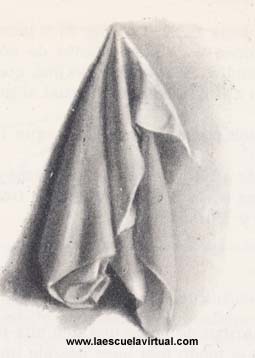






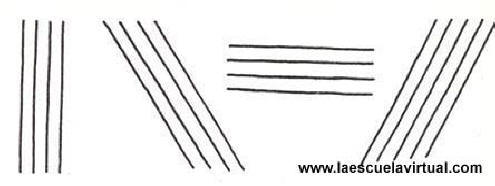





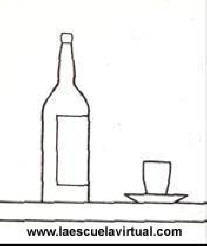

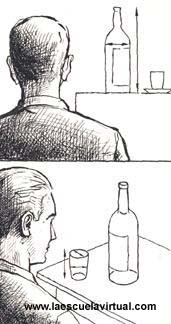 Su posición ante el modelo debe ser ésta. El modelo debe estar a la, altura de sus ojos. Es el modo de que lo vea plano, en sólo dos dimensiones: alto y ancho.
Su posición ante el modelo debe ser ésta. El modelo debe estar a la, altura de sus ojos. Es el modo de que lo vea plano, en sólo dos dimensiones: alto y ancho. 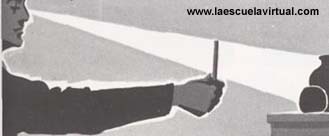
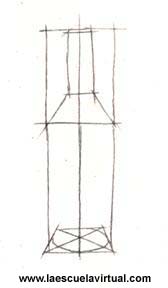
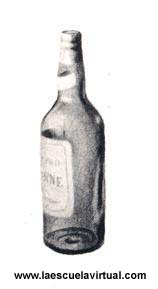
 1.) Observamos la botella real que tenemos delante y vemos su altura y anchura
1.) Observamos la botella real que tenemos delante y vemos su altura y anchura 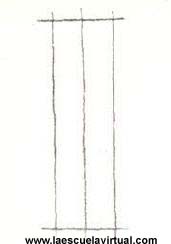 2.) Hacemos después un cuadro que tenga proporcionalmente, esta anchura y altura.
2.) Hacemos después un cuadro que tenga proporcionalmente, esta anchura y altura.  3.) Después podemos trazar alguna línea auxiliar más, tales como la que señalan el comienzo del ensanche del cuello de la botella y el final de dicho ensanche, donde la botella comienza a bajar recta hacia abajo. También una línea que marque el sitio donde el cuello es más grueso y el recuadro de la embocadura.
3.) Después podemos trazar alguna línea auxiliar más, tales como la que señalan el comienzo del ensanche del cuello de la botella y el final de dicho ensanche, donde la botella comienza a bajar recta hacia abajo. También una línea que marque el sitio donde el cuello es más grueso y el recuadro de la embocadura. 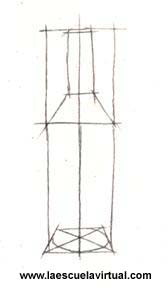 4.) Por último, a base de trazos rectos, dibujamos la forma de la botella, de modo que nos queda terminado el encaje tal como le vemos en esta figura:
4.) Por último, a base de trazos rectos, dibujamos la forma de la botella, de modo que nos queda terminado el encaje tal como le vemos en esta figura: 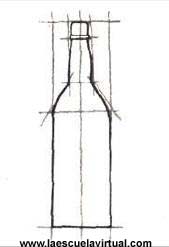 5.) Sobre esto dibujamos la botella definitiva y borramos las líneas del encaje:
5.) Sobre esto dibujamos la botella definitiva y borramos las líneas del encaje: 
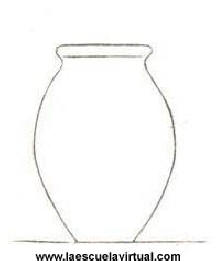 Sin sombrear no sabemos si una figura representa: un cuerpo plano o no
Sin sombrear no sabemos si una figura representa: un cuerpo plano o no 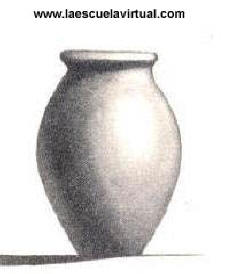 Al dibujar, pues, usted debe dominar esta faceta fundamental del dibujo, pues es gracias a la combinación de luces y sombras como representaremos la forma y volumen de un objeto cualquiera que dibujemos.
Al dibujar, pues, usted debe dominar esta faceta fundamental del dibujo, pues es gracias a la combinación de luces y sombras como representaremos la forma y volumen de un objeto cualquiera que dibujemos.  La luz del Sol, es decir, la luz natural, produce sombras paralelas.
La luz del Sol, es decir, la luz natural, produce sombras paralelas. 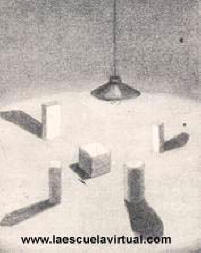 La luz artificial produce sombras radiales.
La luz artificial produce sombras radiales.  La sombra propia es la que se produce en el mismo cuerpo iluminado.
La sombra propia es la que se produce en el mismo cuerpo iluminado. 
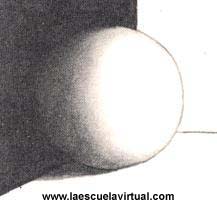

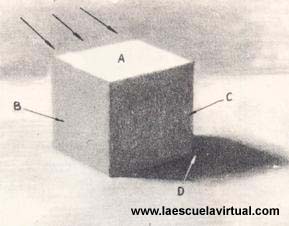 Donde llega más fácilmente la luz en este cubo es: a la cara A, cae de lleno sobre ella, por eso es la más clara, la más iluminada.
Donde llega más fácilmente la luz en este cubo es: a la cara A, cae de lleno sobre ella, por eso es la más clara, la más iluminada. 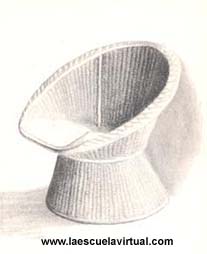 Así se ven las cosas mirando normalmente.
Así se ven las cosas mirando normalmente. 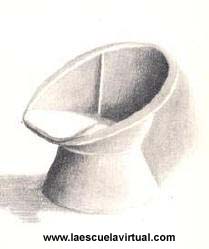 Entornando los ojos, las zonas de sombra y luz se delimitan con mayor claridad.
Entornando los ojos, las zonas de sombra y luz se delimitan con mayor claridad. 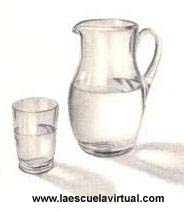 Es preciso tener tacto y sombrear con más suavidad, dando negros y dejando zonas blancas iluminadas.
Es preciso tener tacto y sombrear con más suavidad, dando negros y dejando zonas blancas iluminadas.  No debe entusiasmarse al sombrear y dejar sus trabajos así, demasiado oscuros.
No debe entusiasmarse al sombrear y dejar sus trabajos así, demasiado oscuros. 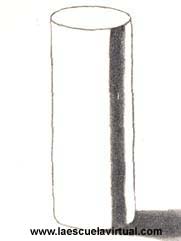 Comparando con la intensidad de este tono...
Comparando con la intensidad de este tono... 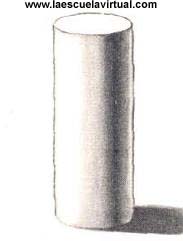 ... vaya graduando el resto.
... vaya graduando el resto. 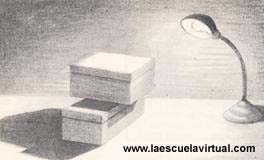
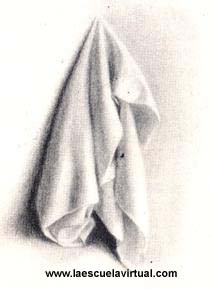 Un trapo colgado, que tenga buena caída, blanco, que colocará tal como ve aquí:
Un trapo colgado, que tenga buena caída, blanco, que colocará tal como ve aquí: 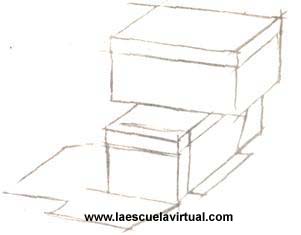 Lo primero es el encaje.
Lo primero es el encaje. 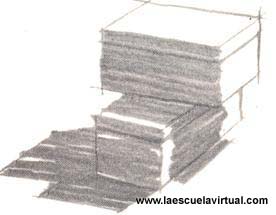 3. Manche usted ya, con el lápiz del n. 2, con un rayado en que no debe apretar demasiado, las zonas de sombra, marcando los diferentes tonos más importantes que ve para lo cual habrá empleado el método de entrecerrar los ojos y sin olvidar que el trazo debe seguir la forma plana o curva de la superficie del modelo.
3. Manche usted ya, con el lápiz del n. 2, con un rayado en que no debe apretar demasiado, las zonas de sombra, marcando los diferentes tonos más importantes que ve para lo cual habrá empleado el método de entrecerrar los ojos y sin olvidar que el trazo debe seguir la forma plana o curva de la superficie del modelo.  4. Manche la zona o zonas más oscuras del dibujo.
4. Manche la zona o zonas más oscuras del dibujo.  5.A partir de este tono y como le hemos indicado, COMPARANDO, vaya dando los otros tonos más suaves, sin olvidar que el paso de uno a otro debe ser suave, sin contraste brusco.
5.A partir de este tono y como le hemos indicado, COMPARANDO, vaya dando los otros tonos más suaves, sin olvidar que el paso de uno a otro debe ser suave, sin contraste brusco. 
